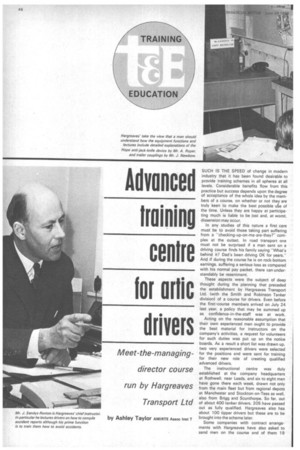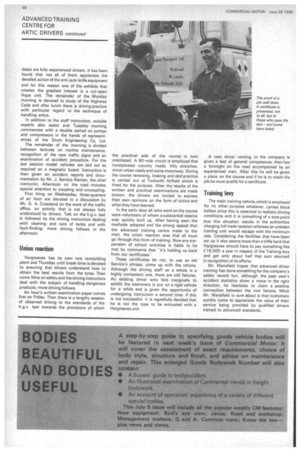Advanced froinin centre for orlic drivers
Page 48

Page 49

Page 50

If you've noticed an error in this article please click here to report it so we can fix it.
Meet-the-managingdirector course run by Hargreaves Transport Ltd
by Ashley Taylor AMIRTE Assoc lost T
SUCH IS THE SPEED of change in modern industry that it has been found desirable to provide training schemes in all spheres at all levels. Considerable benefits flow from this practice but success depends upon the degree of acceptance of the whole idea by the members of a course, on whether or not they are truly keen to make the best possible use of the time. Unless they are happy at participating much is liable to be lost and, at worst, dissension may occur.
In any studies of this nature a first care must be to avoid those taking part suffering from a -checking-up-on-me-are-they?" complex at the outset. In road transport one must not be surprised if a man sent on a driving course finds his family saying "What's behind it? Dad's been driving OK for years.And if during the course he is on rock-bottom earnings, suffering a serious loss as compared with his normal pay packet, there can understandably be resentment.
These aspects were the subject of deep thought during the planning that preceded the establishment by Hargreaves Transport Ltd. (with the Smith and Robinson Tanker division) of a course for drivers. Even before the first.-course members arrived on July 24 last year, a policy that may be summed up as confidence-in-the-staff was at work.
Acting on the reasonable assumption that their own experienced men ought to provide the best material for instructors on the company's activities, a request for volunteers for such duties was put up on the notice boards. As a result a short list was drawn up, two very experienced drivers were selected for the positions and were sent for training for their new role of creating qualified advanced drivers.
The instructional centre was duly established at the company headquarters at Rothwell, near Leeds, and six to eight men have gone there each week, drawn not only from the main fleet but from regional depots at Manchester and Stockton-on-Tees as well, also from Brigg and Scunthorpe. So far, out of about 400 tanker drivers, 205 have passed out as fully qualified. Hargreaves also has about 100 tipper drivers but these are to be brought into the scheme later.
Some companies with contract arrangements with Hargreaves have also asked to send men on the course and of them 19 had passed the test up to mid-June. Usually there are two men from each main depot on every course, limiting the numbers in this manner minimizes the local problem of finding spare drivers.
Artics are steadily gaining ground in the company's fleet and the course may be described as a week's intensive conversion instruction on all aspects of a driver's work in this field. I gather that those taking part receive £25 for the period, less than they would ordinarily reckon to collect when in full flight but no mean sum all the same. At the end of the week, subject to passing written and practical tests, they can look forward to receiving the Hargreaves advanced drivers' certificate signed by Mr. A. P. Mansfield, the managing director, and by the chief instructor.
With some 500 drivers on the strength, it Is not easy for even the keenest managing director to be closely acquainted with them all, but the course has brought Mr. Mansfield into regular contact with men from all branches and he remembers not only the names of those who have passed through the school but also their nicknames, if any.
Group structure
When the first session opens at 8.30 a.m. on the Monday, Mr. Mansfield is there, ready for three-quarters of an hour's discussion, during which he will tell the men something of the group structure, explaining why an operator who wants to stay in business must take care to keep out of the red, describing how the income is spent, where the money comes from to renew the fleet, why particular designs of vehicles are acquired and so on. He also draws the men into conversation so that there is a two-way flow of information. They are told of the service that the customer hopes for and the importance of every individual doing what he can to aid profitability.
During the next Monday morning period the driving instructors speak on differences between artics and rigids, after a break going on to the subject of braking, anti-jack-knife devices and spring brakes. While all the candi dates are fully experienced drivers, it has been found that not all of them appreciate the detailed action of the anti-jack-knife equipment and for this reason one of the exhibits that creates the greatest interest is a cut-open Hope unit. The remainder of the Monday morning is devoted to study of the Highway Code and after lunch there is driving practice with particular regard to the technique of handling artics.
In addition to the staff instructors, outside experts also assist and Tuesday morning commences with a double period on pumps and compressors in the hands of representatives of the Drum Engineering Co. Ltd.
The remainder of the morning is divided between lectures on routine maintenance, recognition of the new traffic signs and an examination of accident procedure. For the last session model vehicles are laid out as required on a magnetic board. Instruction is then given on accident reports and documentation by Mr. J. Sandys-Renton, the chief instructor. Afternoon on the road includes special attention to coupling and uncoupling.
First thing on Wednesday, three-quarters of an hour are devoted to a discussion by Mr. G. A. Crossland on the work of the traffic office, an activity that is not always fully understood by drivers. Talk on the h.g.v. test is followed by the driving instructors dealing with cleaning and care of tanks and with fault-finding; more driving follows in the afternoon.
Union reaction
Hargreaves has its own tyre remoulding plant and Thursday until break-time is devoted. to ensuring that drivers understand how to obtain the best results from the tyres. Then come films on safety and the driving instructors deal with the subject of handling dangerous products; more driving follows.
An hour's written examination paper comes first on Friday. Then there is a lengthy session of observed driving to the standards of the h.g.v. test towards the provisions of which the practical side of the course is now orientated. A 90-mile circuit is employed that incorporates country roads, hilly stretches, minor urban roads and some motorway. During the course reversing, braking and skid practice is carried out at Tockwith Airfield which is hired for the purpose. After the results of the Written and practical examinations are made known, the drivers are invited to express their own opinions on the form of tuition and what they have learned.
In the early days all who went on the course were volunteers of whom a substantial reserve was quickly built up. After having seen the methods adopted and the strong appeal that the advanced training centre made to the men, the union reaction was that all must go through this form of training. Now any suspension of school activities is liable to be met by comments that "it's holding us back from our certificates-.
These certificates do not, to use an old Service's phrase, come up with the rations. Although the driving staff as a whole is a highly competent one, there are still failures. An existing driver who fails marginally to satisfy the examiners is put on a rigid vehicle for a while and is given the opportunity of undergoing instruction a second time. If this is not successful, it is regretfully decided that he is not the type to be entrusted with a Hargreaves unit. A new driver coming to the company is given a test of general competence, then has a fortnight on the road accompanied by an experienced man. After this he will be given a place on the course and if he is to retain his job he must qualify for a certificate.
Training levy
The main training vehicle,which is employed for no other purpose whatever, carries block ballast since this is essential to realistic driving conditions and it is something of a sore point that this situation results in the authorities charging full trade taxation whereas an unladen training unit would escape with the minimum rate. Considering the facilities that have been set up it also seems more than a trifle hard that Hargreaves should have to pay something like 16,000 a year in respect of the Training levy and get only about half that sum returned in recognition of its efforts.
Mr. Mansfield hopes that advanced driver training has done something for the company's safety record but, although the past year's accident statistics show a move in the right direction. he hesitates to claim a positive connection between the two factors. What Mr. Mansfield is sure about is that customers quickly come to appreciate the value of their service being provided by qualified drivers trained to advanced standards.
























































































































